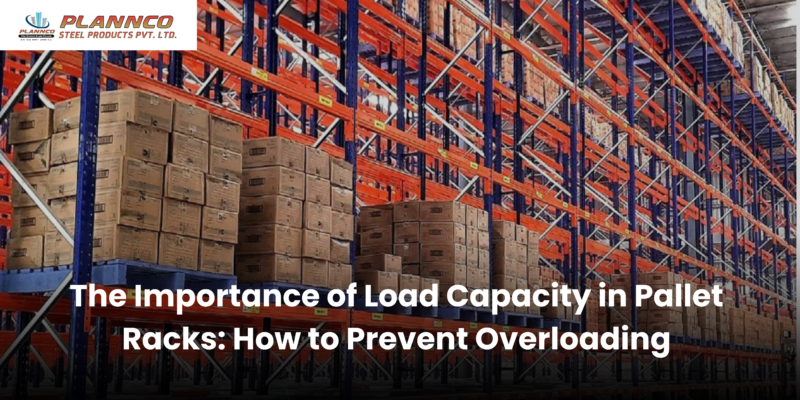
Pallet racks are among the most important tools for handling warehouses. By placing your products, these racks maximize the amount of room you have for storage. But one important factor that is often ignored is pallet racks load capacity, or more simply, the maximum amount of weight that they can support reliably.
Maintaining a safe workplace and smooth business operations depend on you being aware of and mindful of your pallet rack load limits. We’ll discuss the dangers of overloading, why load capacity matters so much, and how to keep it from happening in your warehouse in this blog. We’ll also discuss why Pallet Rack Manufacturers play a role in assisting you in selecting the best racks.
Why Load Capacity is Important for Pallet Racks
The load capacity of a pallet rack tells you the maximum weight it can safely hold. Pushing your racks beyond this limit can lead to serious problems, including:
- Rack collapse: The most dangerous risk of overloading is that the entire rack could collapse, damaging products and possibly injuring employees.
- Product damage: If the shelves start to bend or break under too much weight, your products might get damaged in the process.
- Safety hazards: Overloaded racks are a threat to warehouse safety. Heavy items could fall, putting your workers at risk.
- Shortened rack lifespan: When you overload pallet racks, they wear out faster, meaning you’ll have to spend more money replacing them sooner than expected.
Key Factors That Affect Pallet Rack Load Capacity
To use pallet racks properly, you need to understand what affects their load capacity. This knowledge will help you make smart decisions when choosing racks from pallet rack manufacturers and keep your warehouse safe.
1. Material of the Rack
The material the rack is made from plays a big role in how much weight it can hold. Most pallet racks are made of strong steel, which is great for heavy loads. Pallet rack manufacturers usually list the type of metal used and the weight limits of each rack. Be sure to match the rack material to the types of items you plan to store.
If your business stores extra-heavy or bulky items, it’s best to go for Heavy Duty Pallet Rack. These racks are built for higher loads and are more durable under pressure.
2. Rack Design
The design of the pallet rack also affects how much weight it can support. Here are a few common rack designs:
- Selective racks: The most basic type of rack, where you can easily access each pallet. These racks are flexible, but they usually hold less weight compared to other types.
- Drive-in/Drive-through racks: These racks allow forklifts to move inside the system, offering higher storage capacity. They can support more weight, but you need to be careful about balancing the load properly.
- Cantilever racks: Designed for long items like pipes or lumber, cantilever racks have arms that extend from the frame. The length and strength of these arms determine how much weight they can hold.
Choosing the right rack design from your pallet rack manufacturers depends on your products and how much weight you need to store.
3. Weight Distribution
How you place items on the rack matters just as much as how much weight you put on it. Even if the rack can hold a certain weight, if the load isn’t distributed evenly, you could end up with a serious problem.
To avoid overloading, follow these simple rules:
- Place heavier items on the lower shelves to keep the rack stable.
- Spread out the weight across the shelf, rather than placing it all in one spot.
- Avoid stacking items in ways that could create an imbalance.
Pallet rack manufacturers often include guides on how to load their racks properly, so be sure to follow them.
4. Environmental Conditions
Believe it or not, the environment in your warehouse can affect the strength of your pallet racks. Extreme temperatures or high levels of moisture can weaken the material over time, reducing the rack’s load capacity.
If your warehouse is exposed to these conditions, you might want to consider racks made from special materials like galvanized steel, which is more resistant to rust and corrosion. Heavy-duty rack manufacturers offer these types of racks for businesses that need to operate in harsh environments.
How to Prevent Overloading in Pallet Racks
Preventing overloading in your pallet racks requires some planning, regular checks, and training for your staff. Following these tips can help keep your warehouse safe and efficient.
1. Know the Load Capacity of Your Racks
Before you even start using pallet racks, make sure you know their load capacity. When you buy racks from pallet rack manufacturers, they’ll provide the maximum weight limits for each system. Make sure these limits are clearly marked on each rack and that your team is aware of them.
Never guess the load capacity — always stick to the manufacturer’s guidelines to avoid any issues.
2. Load Racks Properly
Incorrectly loading your pallet racks can easily lead to overloading. Make sure your staff knows the right way to load the racks, including how to distribute weight evenly and where to place heavier items.
Here are a few key tips:
- Heavier items should go on the bottom shelves for better stability.
- Don’t exceed the weight limit on any one shelf, even if it seems like the rest of the rack can handle it.
3. Regular Inspections and Maintenance
Regularly inspect your pallet racks for any signs of wear or damage. Look for:
- Bent shelves or beams.
- Rust or corrosion, especially if your warehouse is in a humid environment.
- Loose bolts or cracked materials.
If you spot any issues, fix them right away to avoid accidents. Many pallet rack manufacturers recommend routine maintenance, so follow their guidelines to keep your racks in top shape.
4. Use Accessories to Protect Your Racks
Several accessories can help you avoid overloading your racks. These include:
- Wire decking: Adds support to your shelves, making them stronger.
- Post protectors: Protect the base of the rack from forklift damage.
- Guardrails: Strengthen the structure of your racks and help prevent accidents.
These add-ons can help extend the life of your pallet racks and keep your warehouse safer.
5. Consider Heavy-Duty Racks for Large Loads
If you’re dealing with especially heavy or bulky products, standard pallet racks might not be enough. That’s when it’s time to look into racks designed by heavy-duty rack manufacturers. These racks are built to handle larger loads and provide the strength and durability you need for heavier storage needs.
Conclusion
The load capacity of your pallet racks is one of the most important factors in keeping your warehouse safe and efficient. By understanding what affects load capacity, following safe loading practices, and working with trusted pallet rack manufacturers, you can prevent overloading and protect your products and employees.
Remember, regular inspections, proper weight distribution, and the right accessories can go a long way in extending the life of your pallet racks. And if your business requires storing heavier items, don’t hesitate to reach out to heavy-duty rack manufacturers for specialized solutions.
By investing time and effort into managing your pallet racks wisely, you’ll create a safer, more organized, and productive warehouse environment.





